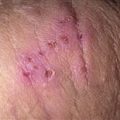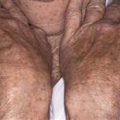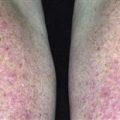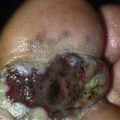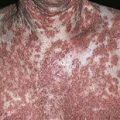3
Acute eczematous
inflammation
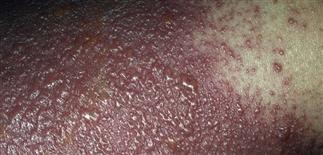
Acute eczema findings: erythema, edema, and vesiculation or bullae. This is intensely itchy, early-onset poison ivy. Acute contact allergy is often characterized by vesiculation.
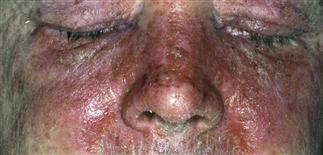
Acute eczematous reaction to 5-fluorouracil to treat actinic keratoses. The skin is erythematous, weeping, and edematous.
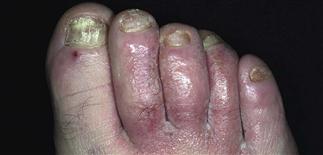
Erythema, edema, vesiculation, and pruritus—all findings of acute eczematous inflammation.
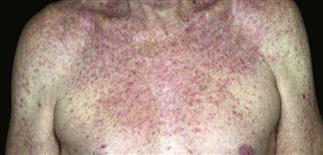
Erythematous papules scattered on the upper chest and arms. Biopsy showed a spongiotic epidermis typical of acute eczematous inflammation.
DESCRIPTION
Acute eczematous inflammation is characterized clinically by erythema, edema, and vesiculation. Weeping and oozing of acute lesions is typical. Pruritus is often severe.
HISTORY
• Multiple causes, including allergic contact hypersensitivity to specific plant allergens such as poison ivy, oak, sumac. • Nickel, topical medicaments (such as bacitracin, neomycin, benzocaine, fragrances), preservatives in personal care products, and rubber additives are also common causes of acute eczema. Irritant dermatitis is common after repeated water, solvent, or detergent exposure. • In an ‘id reaction’, acute eczema with vesicles occurs at a distant site (e.g. hands) from an active fungal infection (e.g. feet). • Stasis dermatitis, scabies, irritant reactions, and dyshidrotic and atopic eczema may present as acute eczema. • If provoking factors can be avoided, eruption improves over 7–10 days, clearing usually by 3 weeks. • Excoriation predisposes to infection and causes serum, crust, and purulent material to accumulate. Excoriation can result in secondary staphylococcal infection, aggravation, and dermatitis prolongation.
PHYSICAL FINDINGS
• Examination finds erythema, edema, vesiculation, and weeping. Inflammation moderate to intense. Tiny, clear, fluid-filled vesicles. Bullae may develop.
FURTHER EVALUATION
• Consider patch testing for delayed-type hypersensitivity if distribution suggests a contact exposure; if problem recurrent or refractory to therapy; or if known occupational, hobby, or other exposure to cutaneous allergens. • Consider mineral oil preparation for scabies, especially in eczema of new or recent onset. Consider scraping scale for potassium hydroxide examination for dermatophyte fungus infection. Blood tests almost never helpful. • Repeated bouts of acute eczema on the face or exposed hands or arms suggest a contact allergic problem—evaluate by patch testing. • Patch testing to patient’s own toiletry products is recommended, along with appropriate testing of occupational allergens with specific allergen trays.
TREATMENT
• Cool, wet dressings and topical steroid creams suppress inflammation and itching. Soak a clean cloth in cool water or Burow’s solution, then place on affected areas for 30 min. Apply an appropriate topical steroid cream (group II or III), rub in well. • Reserve oral corticosteroids for severe or generalized acute eczema. Approximately 1 mg/kg q.d. initially, tapering over 3 weeks. Too short a course may result in recurrence and rebound. • Oral antihistamines such as diphenhydramine (Benadryl) and hydroxyzine (Atarax) can relieve itching; sedative effect promotes sleep. • If secondary infection suspected, culture, review sensitivity, and use an appropriate oral antibiotic for 10–14 days. • Remove all patient’s topicals (lotions, topical over-the-counter medicaments, antiitch preparations); treat with topical steroids only or bland emollients such as plain Vaseline. Keep skin care and exposures minimal and simple.

